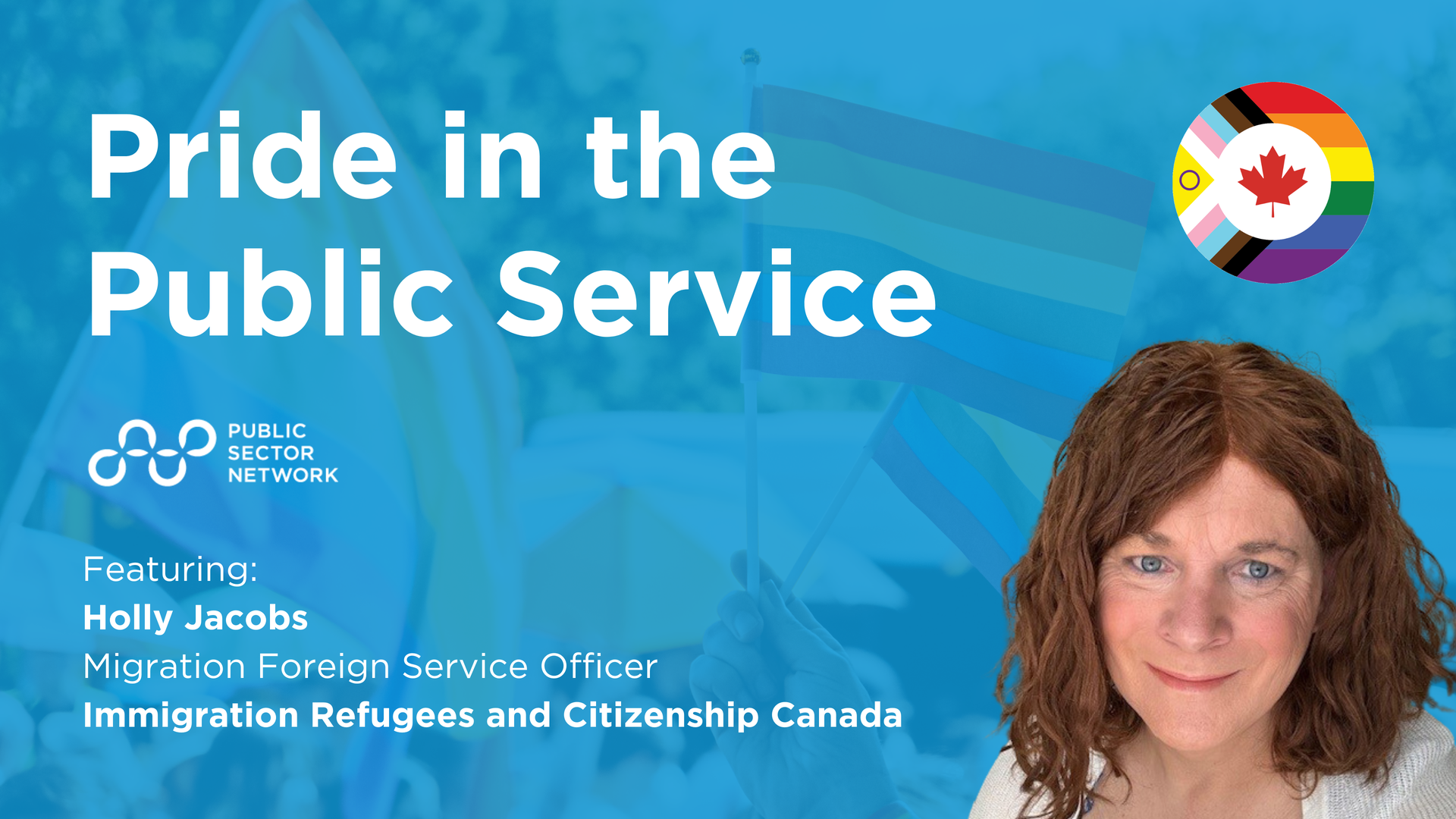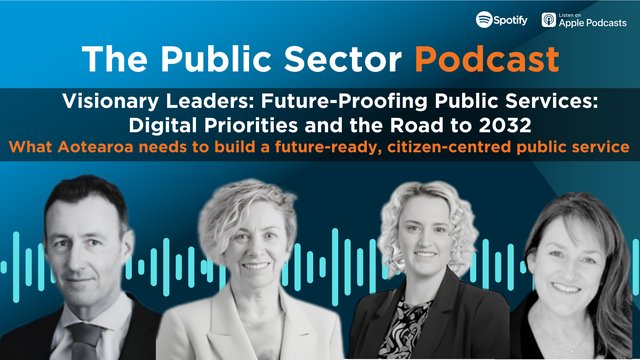
Welcome to this month's featured article, where we shine a spotlight on Holly Jacobs, Migration Foreign Service Officer from Immigration Refugees and Citizenship Canada. In an exclusive interview, Holly opens up about their journey within the public sector, how individuals can actively support the 2SLGBTQIA+ community within their workplaces and beyond, and more! Join us as we delve into the inspiring narrative of Holly Jacobs, a trailblazer committed to driving positive change and shaping a more equitable future for all.
How did you get into the Canadian Public Sector? What has your journey been like so far?
I was that kid who had no idea what they wanted to be when they grew up. I applied for and was rejected from film school, eventually drifted into East Asian Studies, and at one point I considering remaining a professional student forever when life circumstances compelled me to get serious about a career. I went to law school with the dream of working for Amnesty International or Human Rights Watch but graduated into a recession, in debt and a part time single parent. At the time, I was looking for anything. I started my first public service job in 1998 in a junior role in the tax department. I had just come back to Ottawa from Cape Town, where I’d been on an exciting internship with an NGO and it was a hard transition.
I disliked my new bureaucratic life at first, but now see it as an important starting point. I managed to find a research position at the Immigration and Refugee Board that was closer to my human rights passions and then after a few years hopped across the street to Citizenship and Immigration Canada (as it was then known). I spent five years in refugee policy before getting the opportunity for my first posting in 2006 and I was instantly hooked on international operations. The next fifteen years I went to London, Delhi, Tehran, Ottawa, Beirut, Delhi, Ottawa, Ankara and I have loved the opportunities that the foreign service has afforded me. Being closeted was less awesome, especially in Tehran, but I would not trade my overseas experiences for anything. And now that I have transitioned, the prospect of Holly going out on posting is thrilling!
How do you feel like 2SLGBTQIA+ allies within the public sector can better support people in the 2SLGBTQIA+ community?
See us! Engage with us! Learn about us! We don’t bite! Come to our events, march with us and, when we are threatened, defend us and stand with us. Take Positive Space training and display your pronouns where you can. When I see another person’s pronouns, it’s code for “I don’t need to wait and see how this person will react to me”. Especially for those in policy and program design, take GBA+ training and consider everything from data (Canada was the first country in the world to collect census data on our gender-diverse population) to communications (inclusive language and imagery) to implementation and understanding differential impacts.
Finally, small gestures of allyship matter: I have a colleague I have known for decades and when we went virtual I noticed she had a cushion with the progress Pride flag in the background. That sent a lovely signal that I will never forget.
What role do you believe senior leadership should play in championing 2SLGBTQIA+ inclusion and diversity during Pride Month and beyond?
I had the great privilege of accompanying our Public Service Pride Champion Jason Bett to address a very large room full of Deputy Ministers on this very subject! I would start by emphasizing the “beyond”, championing 2SLGBTQIA+ diversity is an ongoing process, not just for Pride Month (obviously!). The Public Service Pride Network has quite a number of resources for managers and executives at all levels, including Inclusive Leadership learning resources, a network that is open to allies as well as members of the community, and there is the Open Letter to Deputy Ministers to take action to support our transgender, non-binary and gender-diverse colleagues in the federal public service which was issued in May 2023 and the follow up issued on May 1st of this year. Our appearance before the Deputy Ministers was on the same day as the release of the follow up letter, and it very clearly spells out what senior leaders can do to promote inclusion. All of these resources are available on our website.
Messaging is also so important! My Department’s internal comms team regularly highlights important days in the 2SLGBTQIA+ calendar and these really tell me that I have a place in our organization. It’s lovely. And finally, creating environments where diversity networks, including Pride networks, can do their work. Providing time and resources and support where possible. When we held the first ever Canada United Kingdom Pride Network Summit in May, the Executive Events communications team from my department generously covered costs that allowed us to make the event fully accessible, with sign language interpretation available in both official languages.
Can you discuss any initiatives or events you've been involved in during past Pride Month celebrations in the Canadian public sector, and how they have impacted you personally or professionally?
I struggled with internalized queer- and trans-phobia for a lot of my life so I am a very late bloomer. But even when I was closeted I was involved. When I was the Migration Program Manager at our embassy in Ankara, Turkey, during Pride Month we convened a panel of local United Nations officials, 2SLGBTQIA+ refugees, and a 2SLGBTQIA+ refugee sponsorship group from Canada to highlight the challenges faced by queer and gender-diverse refugees in Turkey. This will be my first Pride season where I will be actively involved in planning activities. But I had a fun experience at last year’s Parade in Ottawa I’d like to share. It was my first time presenting feminine in public. I was wearing a pink and blue wig, pink sunglasses, a pink skirt and a pink Sailor Moon t-shirt. I was on leave without pay at the time, and just a spectator along the route, but was thrilled to see a contingent from my Department, Immigration, Refugees and Citizenship Canada (IRCC). I spotted someone I had known for a long time and without thinking I called out to him. Bear in mind that I was not yet out, he had no idea that I was trans, and I looked quite different to the person he was used to seeing around the office! To his credit he didn’t bat an eye! We had a nice chat hearing about each other’s lives over the last few years before he had to hurry to regain his place in the parade. This was three weeks before my return to the office after a two year absence on leave without pay, and his friendly casual acceptance put me in a great mindset for my return.
Looking ahead, what are your hopes or aspirations for future Pride Month celebrations within the Canada, particularly in terms of advancing transgender visibility, rights, and acceptance?
I would love to see us move beyond having to counter misinformation and defend against hate. Ideally we would simply be celebrating.
We have amazing trans and queer stand up comedians, musicians, artists. I would also love to see a convergence of Pride and reconciliation with Canada’s indigenous peoples, with more prominence given to Two-spirit elders, storytellers and dancers. I am only beginning to encounter this beautiful way of looking at gender and looking at the world and it would be wonderful if more people knew about it and could respect it.
What piece of advice would you give to your younger self?
START THE HORMONES NOW BEFORE YOU LOSE ALL YOUR HAIR! In all seriousness, I think it would be to be kinder, especially to myself. When I was closeted I felt like I was failing because I lacked the courage to be out, but paradoxically also failing in my attempts to disguise myself as someone I wasn’t. I was confused and angry, with no role models, no support, no guidance and I carried a lot of self loathing when I was young, and I self harmed in both blatant and subtle ways. With the perspective of hindsight, I now feel a lot of compassion and admiration toward younger me. That kid was tough and survived a lot! And I’d like to think they turned out ok!
































